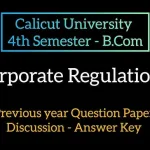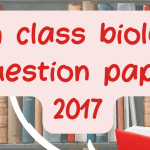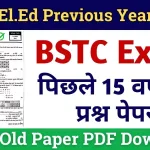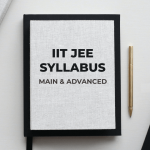Polytechnic education is designed to offer students practical and technical skills in various fields. In the first year of Polytechnic, English is a compulsory subject, and the question paper tests students on their understanding of the language, grammar, and communication skills.
Sample Polytechnic English Question Paper 1st Year
Grammar and Vocabulary
- Question: What is the difference between “their” and “there”?
Answer: “Their” is a possessive adjective, used to show ownership (e.g., “Their books are on the table”). “There” is an adverb, used to refer to a place or position (e.g., “The book is over there”). - Question: How do you form the plural of a noun ending in “s”?
Answer: To form the plural of a noun ending in “s,” you typically add “es” (e.g., “bus” becomes “buses”). - Question: What is a synonym for “happy”?
Answer: A synonym for “happy” is “joyful.” - Question: Define the term “antonym.”
Answer: An antonym is a word that has the opposite meaning of another word (e.g., “hot” is an antonym of “cold”).
- Question: How do you use “in” and “on” correctly in a sentence?
Answer: “In” is used for enclosed spaces or periods of time (e.g., “in the room,” “in June”), while “on” is used for surfaces or specific days (e.g., “on the table,” “on Monday”). - Question: What is the past tense of the verb “go”?
Answer: The past tense of the verb “go” is “went.” - Question: What is the difference between “effect” and “affect”?
Answer: “Effect” is a noun that refers to the result of a change (e.g., “The effect of the rain was flooding”). “Affect” is a verb that means to influence something (e.g., “The rain will affect the game”).
- Question: How do you form a question in English?
Answer: To form a question in English, you usually start with a helping verb (e.g., “is,” “are,” “do,” “does”) followed by the subject (e.g., “Is she coming?”). - Question: What is the correct usage of “your” and “you’re”?
Answer: “Your” is a possessive adjective (e.g., “Your book is on the table”). “You’re” is a contraction of “you are” (e.g., “You’re going to the store”). - Question: What is a preposition? Give an example.
Answer: A preposition is a word that shows the relationship between a noun (or pronoun) and other words in a sentence (e.g., “in,” “on,” “at”). Example: “The cat is on the roof.” - Question: Define “conjunction” and provide an example.
Answer: A conjunction is a word used to connect clauses or sentences (e.g., “and,” “but,” “or”). Example: “She went to the park, and he followed her.” - Question: What is the plural form of “child”?
Answer: The plural form of “child” is “children.” - Question: How do you use “has” and “have” correctly?
Answer: “Has” is used with singular third-person subjects (e.g., “He has a car”), and “have” is used with plural subjects and the pronouns “I,” “we,” “you,” and “they” (e.g., “I have a book”). - Question: What is an adverb? Give an example.
Answer: An adverb is a word that modifies a verb, adjective, or another adverb, usually indicating how, when, where, or to what extent something happens (e.g., “quickly,” “yesterday”). Example: “She sings beautifully.” - Question: What is the opposite of “dark”?
Answer: The opposite of “dark” is “light.” - Question: How do you use “who” and “whom” correctly?
Answer: “Who” is used as a subject (e.g., “Who is coming to the party?”), while “whom” is used as an object (e.g., “Whom did you invite to the party?”). - Question: What is the past tense of “eat”?
Answer: The past tense of “eat” is “ate.” - Question: Define the term “homophone” and give an example.
Answer: A homophone is a word that sounds like another word but has a different meaning and spelling (e.g., “bare” and “bear”). - Question: What is an adjective? Provide an example.
Answer: An adjective is a word that describes a noun or pronoun (e.g., “beautiful,” “tall”). Example: “She has a beautiful dress.” - Question: How do you use “its” and “it’s” correctly?
Answer: “Its” is a possessive pronoun (e.g., “The dog wagged its tail”), while “it’s” is a contraction of “it is” or “it has” (e.g., “It’s going to rain”).
Reading Comprehension
- Question: What is the main idea of a passage?
Answer: The main idea is the central point or message that the author wants to convey in the passage. - Question: How can you identify supporting details in a passage?
Answer: Supporting details are the facts, examples, and information that explain or support the main idea. - Question: What is a summary of a passage?
Answer: A summary is a brief statement that includes the main points and important details of a passage, without including unnecessary details. - Question: How do you infer the meaning of a word from context?
Answer: To infer the meaning of a word from context, you look at the surrounding words and sentences to understand what the word means. - Question: What is the purpose of a topic sentence in a paragraph?
Answer: The topic sentence introduces the main idea of the paragraph and sets the stage for the supporting details. - Question: What is the difference between a fact and an opinion?
Answer: A fact is a statement that can be proven true, while an opinion is a belief or feeling that cannot be proven. - Question: How do you identify the author’s tone in a passage?
Answer: The author’s tone is the attitude or feeling expressed in the writing, which can be identified through word choice and style. - Question: What does it mean to make a prediction while reading?
Answer: Making a prediction involves guessing what will happen next in the passage based on clues from the text. - Question: How do you determine the theme of a story?
Answer: The theme is the underlying message or lesson that the author wants to convey, often related to human nature or life. - Question: What is the role of a conclusion in a passage?
Answer: The conclusion sums up the main points and often provides a final thought or reflection on the topic. - Question: How do you identify cause and effect in a passage?
Answer: Cause and effect refer to the relationship between events where one event (the cause) leads to another event (the effect). - Question: What is the difference between a summary and a paraphrase?
Answer: A summary is a brief overview of the main points, while a paraphrase is a restatement of the text in your own words. - Question: How do you recognize bias in a passage?
Answer: Bias is a tendency to favor one side over another, often shown through the author’s choice of words or selective presentation of facts. - Question: What is a narrative passage?
Answer: A narrative passage tells a story, often with a clear sequence of events and characters. - Question: How do you analyze the structure of a passage?
Answer: Analyzing the structure involves looking at how the passage is organized, such as the order of ideas, use of headings, and paragraph structure. - Question: What does it mean to synthesize information from a passage?
Answer: Synthesizing information means combining ideas from different parts of the passage to form a new understanding or conclusion. - Question: How do you identify the point of view in a passage?
Answer: The point of view is the perspective from which the passage is written, such as first-person, second-person, or third-person. - Question: What is a persuasive passage?
Answer: A persuasive passage is written to convince the reader of a particular viewpoint or action. - Question: How do you identify the setting in a story?
Answer: The setting is the time and place in which the story takes place, and it can often be identified through descriptive details. - Question: What is the significance of the title of a passage?
Answer: The title often provides insight into the main idea or theme of the passage and can give clues about the content.
Writing Skills
- Question: What is the structure of a basic paragraph?
Answer: A basic paragraph consists of a topic sentence, supporting sentences, and a concluding sentence. - Question: How do you write a thesis statement?
Answer: A thesis statement is a sentence that presents the main argument or point of your essay. It should be clear and concise. - Question: What is the importance of a topic sentence in a paragraph?
Answer: The topic sentence introduces the main idea of the paragraph and guides the reader on what to expect. - Question: How do you write a conclusion for an essay?
Answer: A conclusion summarizes the main points of the essay and provides a final thought or reflection on the topic. - Question: What is a compound sentence?
Answer: A compound sentence is a sentence that contains two or more independent clauses joined by a conjunction (e.g., “and,” “but,” “or”). - Question: How do you use transition words in writing?
Answer: Transition words help to connect ideas and ensure the smooth flow of the text (e.g., “however,” “therefore,” “in addition”). - Question: What is the difference between active and passive voice?
Answer: In active voice, the subject performs the action (e.g., “The dog chased the cat”). In passive voice, the action is performed on the subject (e.g., “The cat was chased by the dog”). - Question: How do you write an effective introduction for an essay?
Answer: An effective introduction grabs the reader’s attention, provides background information, and presents the thesis statement. - Question: What is the purpose of an outline before writing?
Answer: An outline helps organize ideas and plan the structure of the writing before beginning to write the full text. - Question: How do you write a narrative essay?
Answer: A narrative essay tells a story, often from the writer’s perspective, with a clear beginning, middle, and end. - Question: What is a descriptive essay?
Answer: A descriptive essay provides detailed descriptions of a person, place, or thing, using sensory details to create a vivid picture for the reader. - Question: How do you develop a strong argument in an essay?
Answer: To develop a strong argument, present clear reasons, provide evidence, and address counterarguments. - Question: What is the purpose of a concluding sentence in a paragraph?
Answer: The concluding sentence wraps up the paragraph and reinforces the main idea. - Question: How do you avoid plagiarism in writing?
Answer: To avoid plagiarism, always cite sources when using someone else’s ideas or words, and paraphrase information in your own words. - Question: What is the difference between formal and informal writing?
Answer: Formal writing is structured and professional, often used in academic and business settings, while informal writing is more casual and conversational. - Question: How do you write a compare and contrast essay?
Answer: A compare and contrast essay discusses the similarities and differences between two subjects, often in a structured way that highlights their relationship. - Question: What is the purpose of a persuasive essay?
Answer: The purpose of a persuasive essay is to convince the reader to accept a particular viewpoint or take a specific action. - Question: How do you write a research paper?
Answer: Writing a research paper involves choosing a topic, conducting research, organizing information, and presenting an argument supported by evidence. - Question: What is an expository essay?
Answer: An expository essay explains a topic or idea in a clear and straightforward manner, providing information and analysis without personal opinions. - Question: How do you write a reflective essay?
Answer: A reflective essay involves exploring personal experiences and reflecting on their meaning or impact, often with a focus on learning and growth.
Exam Preparation Tips
Preparing for the Polytechnic English exam involves understanding the syllabus, practicing sample questions, and developing good study habits. Below are some tips to help you prepare effectively:
- Understand the Syllabus: Make sure you are familiar with the topics covered in the syllabus. Focus on grammar, reading comprehension, writing skills, and vocabulary.
- Practice Regularly: Practice past question papers and sample questions to get a feel for the exam format and types of questions.
- Time Management: Develop a study schedule that allows you to cover all the topics, and practice time management during the exam to ensure you can complete all sections.
- Read Widely: Read a variety of texts, including books, articles, and essays, to improve your reading comprehension and vocabulary.
- Seek Feedback: If possible, get feedback on your writing from teachers or peers to identify areas for improvement.
- Stay Relaxed: On the day of the exam, stay calm and focused. Read each question carefully and take your time to answer thoughtfully.
Exam Pattern
The Polytechnic English exam usually includes different sections such as:
- Grammar and Vocabulary: Questions on grammar rules, word meanings, synonyms, antonyms, and sentence formation.
- Reading Comprehension: Passages followed by questions testing understanding and interpretation.
- Writing Skills: Tasks like essay writing, letter writing, or paragraph writing.
- General English: Questions on basic English usage and communication skills.
Latest Posts
- Step-by-step guide to download and apply for jee mains admit card 202
- Comprehensive 2025 government holidays and recruitment details for job seekers
- JEE Mains Admit Card 2025: Your Step-by-Step Guide to Downloading the Hall Ticket
- Everything You Need to Know About 2025 Government Holidays Recruitment
- Comprehensive Guide to rrb d group recruitment 2025 – Eligibility, Vacancies, and Application
- Detailed guide to nps trust recruitment 2025 vacancies, eligibility and apply process
- Comprehensive guide to hpcl recruitment 2025 notification, vacancies, and application process
- ignou bed admission 2025 complete recruitment guide with eligibility and process
- Comprehensive Guide to Indian Army Agniveer Recruitment 2025 Notification and Jobs
- Everything You Must Know About CBSE Board Exams 2025 Changes & New Rules






